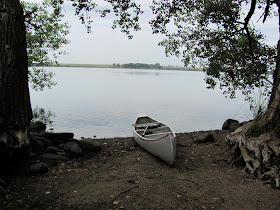Last night the forecast was for a calm day with a
temperature in the 90s, and it seemed like a good day ahead for a cruise. I loaded up my kayak in the late
evening and got ready to depart home at 6:00 a.m. for my morning read and
coffee. When I walked outside, though, I felt the first few raindrops and the
sky was overcast. Still, I was
ready to depart, so I headed out.
I got to Lake Alvin by 8:30 a.m. and found myself in a thundershower
with lightening flashing, thunder booming, and rain falling. Rather than give up the cruise, I hung
around for 30 minutes or so until the lightening and thunder passed and the
clouds began lightening in the west and north.
Today, I decided to put in at the recreation area on the
north shore and paddle south to Nine Mile Creek. The lake surface ranged from flat calm in sheltered areas to
small wind waves over more open waters.
I was curious to see the latest effects of the prolonged
drought we have been experiencing here on the northern plains, especially in
southeaster South Dakota. The lake
is full, and there did not seem to be any change in surface conditions. The water was relatively clear, no
algae was obvious on the surface, and the level seemed only slightly lower than
normal. The dock seemed to be
elevated about six inches or so more than normal; it would have been difficult
to clamor out of the kayak onto the dock with waters at this level.
The real test of how drought conditions are playing out in
the Lake Alvin system, it seemed to me, would be to head up Nine Mile
Creek. People had told me that
passage into the creek was not possible now; but, I wanted to see how far I
might make it anyway.
Heading down the lake to the south end, it is important to
keep to the left bank, especially after passing the public access site on the
southwest shore. A sand bank or
bar tends to develop at the mouth of Nine Mile Creek as it flows into Lake
Alvin, and that condition was evident today.
I kept to the left bank and still ran aground a few
times. In these situations, I remember
what I think of as the “Pete Larson Clawing Technique.” On a trip down Split Rock Creek a few
years ago, we tended to frequently come across shallow gravel or sand bars
across the waterway. Rather than
trying to pole through these shallows with the paddle, he demonstrated how you
can just reach down into the water and claw your way along the bottom and ease
through such shallows. The act of
clawing lifts the kayak bottom a little, and the grip through the sand or
gravel propels the boat through into deeper water. I used this technique in
passing over the bar leading into Nine Mile Creek today.
Once into the creek, the channel was deep enough to easily
make my way upstream about two-thirds of my normal route. Water depth tended to be 1.5 to 2.5 feet
through the channel – plenty of depth for a kayak. The narrower the course of the creek, the deeper the channel
appeared. Trouble developed mostly
when the course became wider, although it was only necessary to back off a
little and move over some to find the channel.
I came across lots of birds, including a great blue heron,
but they generally flew off as I approached. One duck seemed to lead me for a while through the channel.
As I neared the point where I usually have to turn back, I
found it impossible to continue.
This was the first clear evidence of drought. The flow of the creek had diminished to the point where the
kayak would no longer clear the bottom.
I was able to easily turn back, again using the crawl, and move back
downstream toward the lake.
After exiting Nine Mile Creek, I kept to the eastern shore
and proceeded up the lake to the boat launch within the recreation area.
Mine was the only boat on the lake, and I only saw one guy
fishing along the southwestern bank.
A couple of SDGFP guys were working on the road within the recreation
area. Otherwise, as normal on a
weekday, I was along on the lake and in the park.
As I have often reflected, Lake Alvin is really a good spot
for a cruise, especially a cruise that combines open lake and creek
paddling. Lake Alvin does not have
any cabins along the shore, so it seems more secluded than some other popular
lakes. It is a “wake free” waterway, so any other traffic would be slow moving
fisherman or people in kayaks or canoes. But then, on weekday mornings, there
are generally no other people about.
I’m glad that I waited out the passing storms and was able
to enjoy a couple of hours paddling on Lake Alvin this morning.




















































